Fire door safety: what you need to know

Fire doors are important safety features of any public building and so it’s vital that they provide the highest level of protection. In order to prevent the spread of fires and save lives, fire doors should be checked and maintained on a regular basis to ensure they are in full working order at all times. Martin Smith, product manager at IronmongeryDirect, gives his advice on what to look out for when maintaining fire doors.
Regular maintenance checks need to be carried out on all components of a fire door in order to avoid liability and ensure the safe operation of the door. These should include visual checks which help to identify general wear and tear and damages. Mechanical checks are also beneficial in ensuring components such as door closers and hold open devices are fully functional.
When carrying out maintenance on fire doors it’s important to know what components need to be checked and to what specification. From seals to hinges, door closers and opening devices, all components of a fire door should be checked regularly to ensure they are in full working order at all times.
Seals
Intumescent strips are an extremely important component of fire doors as they expand during a fire, filling the gap between the door and the door frame and preventing the spread of fires and smoke.
Intumescents can expand up to ten times their original size during a fire so it’s vital that the correct and appropriate intumescent is used in accordance with the fire door safety label. They should be firmly set in place and free from any damage or general wear and tear.
Brush and fin type seals, particularly useful for reducing friction and noise, should be free from damage and be continuous around the frame or door leaf. If the fire door has a drop –down seal these also need to be checked to make sure they are dropping downwards when the door is closed.
Hinges, locks and latches
Hinges, locks and latches are all equally important when considering the different hardware components of a fire door. If these are not regularly maintained or replaced when broken the risk of the fire door not doing its job correctly during a fire is extremely high.
When it comes to hinges, fire doors need a minimum of three to operate correctly. These should be fitted with the right amount of screws at the right size and marked with a CE stamp and BSEN 1935. They should be routinely checked for any leakages or metal fragments that are signs of wear and should be treated if they are showing any rust or corrosion.
Locks and latches also need to be considered as they help to ensure a door remains closed within its frame. The latch should hold the door firmly in place without rattling and have the correct intumescent sleeve to retain the doors integrity. They should be CE marked to BS EN 12209 and further product certification by a third party is recommended.
Door closers
Another important feature to consider when checking the upkeep of a fire door is its door closer. Automatic closing devices should be fitted to all fire doors and be capable of closing the door from any angle of opening. This can be tested by opening the door to five degrees and making sure it closes and engages with the latch.
Another factor to bear in mind is that most door closers are graded with a power size. This needs to be a minimum of size 3 for a fire door; any lower than this and it is not considered suitable and needs to be changed immediately.
Hold open devices
Hold open devices such as the Dorgard Fire Door Holder are a great way of legally holding open fire doors instead of using a wedge or other device, which is against fire regulations. These devices, used together with a door closer, will activate after hearing a fire alarm allowing the door to close automatically.
These devices need to be maintained and tested on a regular basis. The unit must be located in the vicinity of the active alarm or bell in order to operate correctly.
Fire doors are a fundamental part of fire protection. All components need to be checked on a regular basis and repaired or replaced by qualified tradespeople if they are found to be damaged or broken. It’s essential to consider every detail when maintaining and checking fire doors in order that they provide the maximum protection against the spread of fires.
For more information, please visit www.IronmongeryDirect.co.uk
T: 0808 168 28 28





